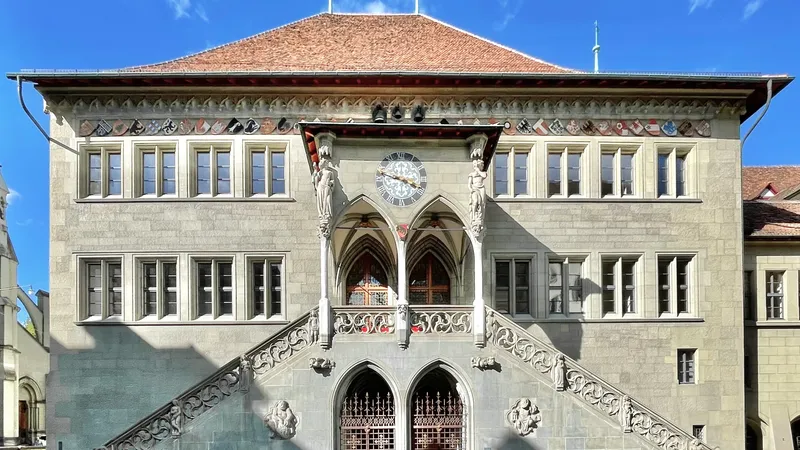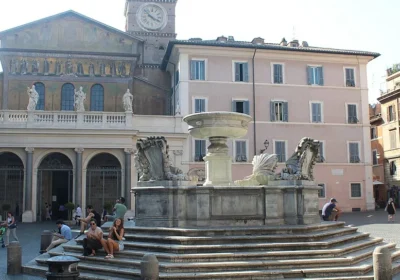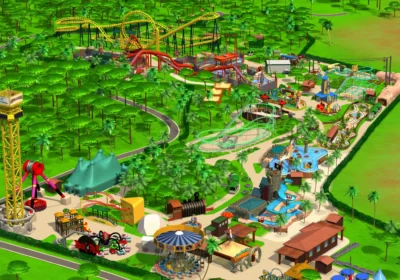Bern (German: Bern, French: Berne, Italian: Berna, 550 metres above sea level, with an agglomeration of about 300,000 inhabitants)
Bern is located in the centre of the country, in the valley of the Aara River. Berna, 550 m above sea level, with an agglomeration of about 300,000 inhabitants)
Bern is located in the centre of the country, in the valley of the river Aara. The city centre with its medieval buildings is a UNESCO World Heritage Site.
Bern is the capital of the eponymous canton of Bern and the de facto capital of the confederation, which has been the seat of the federal government since 1848.
MEMORIAL NOTES
The Church of St. Peter and Paul (German: Kirche Sankt Peter und Paul). The building was built between 1858 and 1864. It was the first Catholic church in Bern in the immediate vicinity of the city hall. This church is the result of an international competition. The church plan came from Paris (architect Pierre Joseph Edouard Deperthes) and the style has Romanesque to early Gothic features.
Bern Cathedral (German: Berner Münster) is considered the most important late Gothic church in Switzerland. Its construction began in 1421, but the church (or rather, its tower) was not completed until 1893. It is the tallest cathedral in Switzerland and is listed as a cultural heritage of national importance. Above the main entrance to the cathedral is one of the most complete collections of late Gothic sculptures in Europe. The figural composition is an illustration of the Last Judgement. It is the only one to have survived the Reformation.
Bear Pit (German: Bärengraben). The bear is the symbol of Bern, so the bear pit has become an integral part of the city.
Swiss Federal Palace (German: Bundeshaus), where the federal parliament and the federal council meet. The parliament building was designed by architect Hans Auer, inspired by the Italian Renaissance cathedral in Florence. It is a symbol of Swiss democracy and one of the symbols of the national patrimony. The palace was opened to the public in 1902.
The Clock Tower (German: Zytgloggeturm) is the main attraction of the city. The tower was built back in the early 13th century as a watchtower, after which it served both as a prison and simply as the centre of city life and a civic memorial. The astronomical clock by Caspar Brunner did not grace the tower until the 16th century (1527-1530).
Berner Fountains (German: Berner Brunnen). Bern’s well fountains are world famous. Each has its own long history. Between 1542 and 1546, the existing wooden fountains were replaced by stone fountains with typical Bern sculptures, most of which were created by the Freiburg sculptor Hans Ging.
City Hall (German: Rathaus). This building is still the political centre of the city and the canton of Bern. It was built between 1406 and 1415 in the Gothic style under the direction of the architects Heinrich von Gegenbach and Hans Hetzel, and has been in use since 1414.
MUSEUM
MUSEUM
Museum of Art (German Kunstmuseum). The museum’s collection consists of paintings, sculptures and art objects created before the end of the 19th century. Among others is a collection of Italian Primitivists from the 14th century. The Impressionists include Monet, Manet, Cézanne and Delacroix, as well as several paintings by the great Surrealists, including Salvador Dalí. In the museum you will find paintings by Kandinsky, Matisse, Kirchner, Picasso and others, as well as contemporary Swiss artists. Historisches Museum (German: Historisches Museum). The museum building is a neo-Gothic style castle. Inside are kept ancient relics, archaeological, ethnographic and numismatic collections. Of interest is a series of 15th century tapestries belonging to the Dukes of Burgundy. The Paul Klee Centre (German: Zentrum Paul Klee). The museum features more than 4,000 works by the renowned Swiss artist and graphic artist Paul Klee, one of the major figures of the European avant-garde. Among others, there are 40 oil paintings, 2,000 drawings, and many gouaches and watercolours. The Albert Einstein Museum House. From 1903 to 1905, Albert Einstein rented a flat on the first floor of the house at Kramgasse, 49. In 1905 he wrote his “Theory of Relativity” here.

















